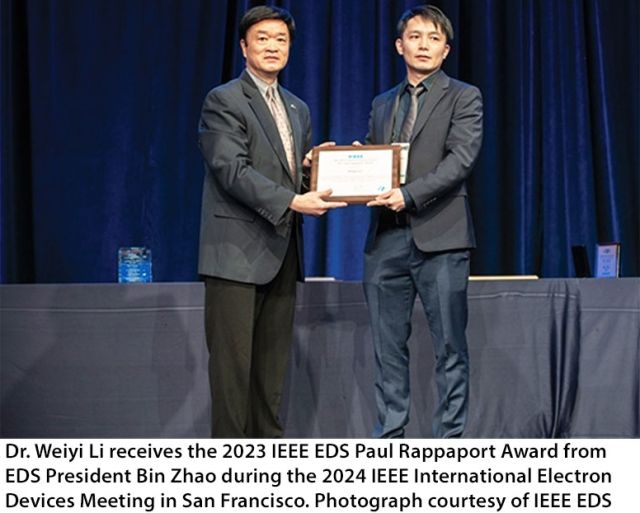Mishra Group: IEEE Best Paper
ECE alumnus Weiyi Li (PhD '22) and members of ECE Prof. Umesh Mishra's group receive recognition for their breakthrough results that could pave the way for higher-performing, lower-cost wireless systems

From the COE News article "UCSB Research Team Wins IEEE Best-Paper Award"
Late last year, a research team led by UC Santa Barbara ECE alumnus Weiyi Li (PhD ’22), who earned his doctorate in the lab of Umesh Mishra, dean of the UCSB College of Engineering, received the Paul Rappaport Award for the best paper in the journal IEEE Transactions on Electron Devices. Selected from more than a thousand articles published in the journal in 2023, the paper describes using an N-polar GaN transistor grown on sapphire substrate to achieve record power and efficiency at W-band (94 GHz), potentially paving the way for a new generation of higher-performing, lower-cost wireless systems.
“I’m extremely pleased that Weiyi Li and his colleagues, several of whom I know well from their time as doctoral students or postdocs in my lab, received the IEEE’s Paul Rappaport best-paper honor for 2023,” said Umesh Mishra. “This is exciting news and further confirmation of the leading role that UCSB continues to play in pushing gallium nitride forward to achieve more power and greater efficiency at reduced cost. I offer congratulations to Weiyi and his collaborators, all of whom powerfully represent their UCSB pedigree.”
“The award provides welcome recognition of our work in N-polar GaN [gallium nitride] from both academia and industry, and a strong endorsement of the quality of our research,” said Li, who is now working as an analog design engineer for Texas Instruments and received the award, a certificate, and a check for $2,500 at the IEEE International Electron Devices Meeting (IEDM) in December 2024.
The paper, a collaborative effort by some nine PhD graduates who were or are affiliated with the Mishra group, including two who are currently postdoctoral researchers in the lab, focuses on the development of N-polar GaN-on-sapphire transistors for mm-wavelength (short wave) communication applications. “N-polar” describes a specific crystal orientation in materials such as GaN, in which the nitrogen atoms are positioned at the surface, unlike in Ga-polar materials, where the gallium atoms are on the surface.
Mishra is one of several renowned researchers who have made UCSB a world leader in GaN-based electronics, and has been since materials professor and Nobel Laureate Shuji Nakamura used it to develop the blue LED, which led to a world revolution in long-lasting, energy-efficient lighting.
Historically, GaN-based power amplifiers have been fabricated on a costly substrate of silicon carbide (SiC). Sapphire, which is cheaper and widely used in LED manufacturing, has been largely overlooked as a replacement for SiC in wireless-communication applications, because it dissipates heat poorly, a limitation that can result in a device overheating during operation. By developing N-polar GaN transistors grown on sapphire, Li’s team successfully demonstrated record-breaking efficiency and power performance at 94 GHz in the W-band spectrum, an Extremely High Frequency (EHF) range used in applications that include radar and high-speed wireless communication. “The device reported in this paper outperforms conventional devices in both efficiency and power,” Li said.
IEEE Transactions on Electron Devices “Record RF Power Performance at 94 GHz From Millimeter-Wave N-Polar GaN-on-Sapphire Deep-Recess HEMTs”